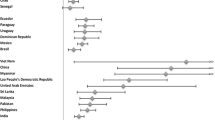Abstract
We characterized a contemporary, nonhospitalized population with angina pectoris by obtaining data from a geographically diverse cohort of 5125 outpatients with chronic stable angina cared for by 1266 primary-care physicians. Diagnosis was based on history supported by evidence for coronary artery disease (coronary angiography, old myocardial infarction [MI], and/or an abnormal stress test). Their mean age was 69 years and 53% were women. Seventy percent had more than one associated illness, and 65% used more than one cardiovascular drug. Calcium antagonists (46%) and nitrates (61%) were used most frequently. Median angina frequency was approximately 2 episodes/week, and increased angina frequency was associated (P < 0.0001) with decreased overall feeling of well-being. Although effort angina was present in 90% of patients, 47% also had rest angina and 34% had mental stress–evoked angina. Female gender (odds ratio: 1.09; 95% CI: 1.02–1.16), concomitant illness (1.17, 1.09–1.25), and pharmacotherapy (1.14, 1.07–1.22) were associated with rest angina. Younger age (1.30, 1.20–1.41), female gender (1.16, 1.07–1.26), concomitant illness (1.13, 1.03–1.24), and pharmacotherapy (1.28, 1.15–1.93) were associated with mental stress angina. Calcium antagonists were used for rest-evoked (1.09, 1.03–1.16) and mental stress–evoked (1.12, 1.04–1.21) angina. These data suggest that contemporary outpatients with angina are most likely to be women and elderly patients with high frequencies of associated illness, calcium antagonist and nitrate use, as well as rest- and mental stress–related angina. These characteristics differ from previous perceptions.
Similar content being viewed by others
References
Pepine CJ, Abrams J, Marks RG, Morris JJ, Scheidt SS, Handberg E for the TIDES Investigators. Characteristics of a contemporary population with angina pectoris. Am J Cardiol 1994;74:226–231.
National Center for Health Statistics. Prevention Profile. Health, United States 1991. Hyattsville, MD: Public Health Service 1992. US Department of Health and Human Services publication (PHS) 92–1232:19 and 121.
Heberden W. Some account of a disorder of the breast. Med Trans (Published by College of Physicians, London) 1772;2:59.
Herrick JB, Nuzum FR. Angina pectoris: Clinical experience with two hundred cases. JAMA 1918;70:67–70.
Sigler LH. Prognosis of angina pectoris and coronary occlusion: Follow-up 1,700 cases. JAMA 1951;146:998–1004.
Block WJ, Crumpacker EL, Dry TJ, Gage RP. Prognosis of angina pectoris: Observations in 6,882 cases. JAMA 1952; 150:259–264.
Kannel WB, Feinleib M. Natural history of angina pectoris in the Framingham study. Prognosis and survival. Am J Cardiol 1972;29:154–163.
Frank CW, Weinblatt E, Shapiro S. Angina pectoris in men: Prognostic significance of selected medical factors. Circulation 1973;47:509–517.
Mock MB, Ringqvist I, Fisher LD, et al. Survival of medically treated patients in the Coronary Artery Surgery Study (CASS) Registry. Circulation 1982;66:562–568.
Nesto RW, Zarich SW, Kowalchuk GJ, Kenigsberg AE, Shrumur SW, McAliffe LS. Frequency of symptoms suggestive of dynamic coronary artery disease in patients referred for coronary angiography. Am J Cardiol 1989;64:1374–1376.
Steering Committee, Transdermal Nitroglycerin Cooperative Study. Acute and chronic antianginal efficacy of continuous twenty-four hour application of transdermal nitroglycerin. Am J Cardiol 1991;68:1263–1273.
Gandhi MM, Lampe FC, Wood DA. Incidence, clinical characteristics, and short-term prognosis of angina pectoris. Br Heart J 1995;73:193–198.
Maseri A, Chierchia S, Kaski JC. Mixed angina pectoris. Am J Cardiol 1985;56:30E–33E.
Author information
Authors and Affiliations
Rights and permissions
About this article
Cite this article
Pepine, C.J. Angina Pectoris in a Contemporary Population: Characteristics and Therapeutic Implications. Cardiovasc Drugs Ther 12 (Suppl 3), 211–216 (1998). https://doi.org/10.1023/A:1017193011667
Issue Date:
DOI: https://doi.org/10.1023/A:1017193011667




